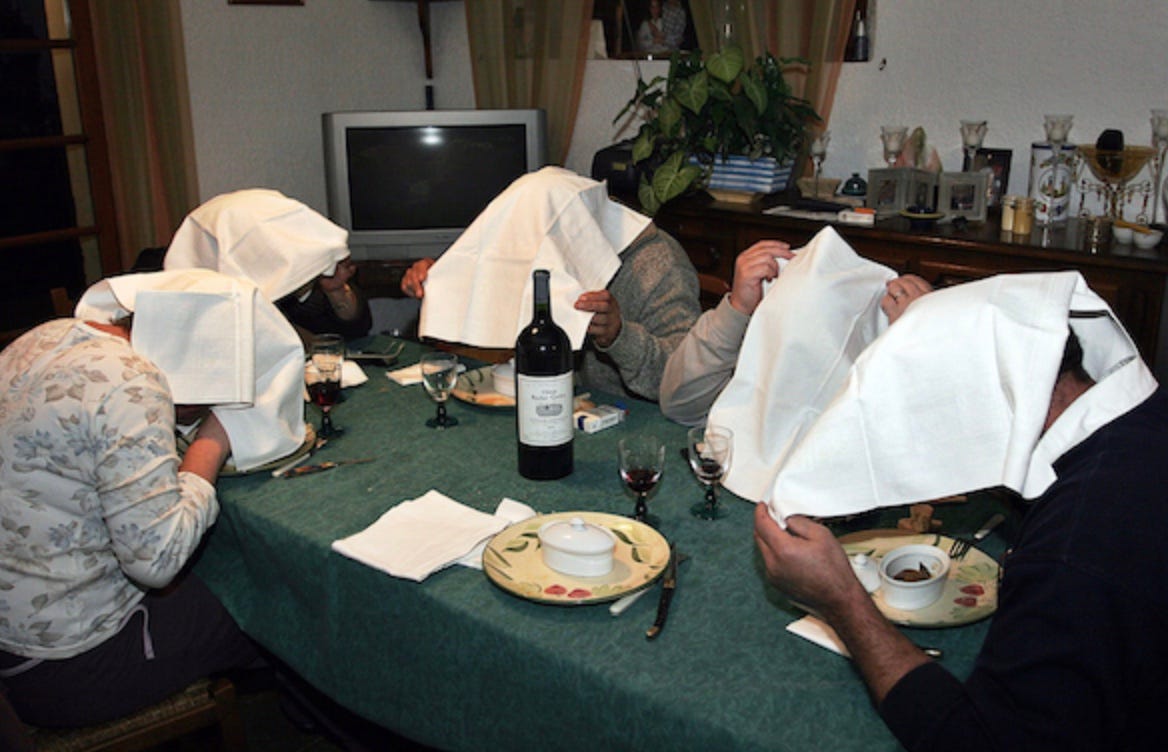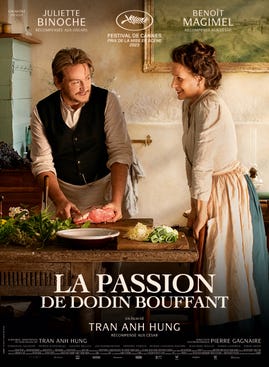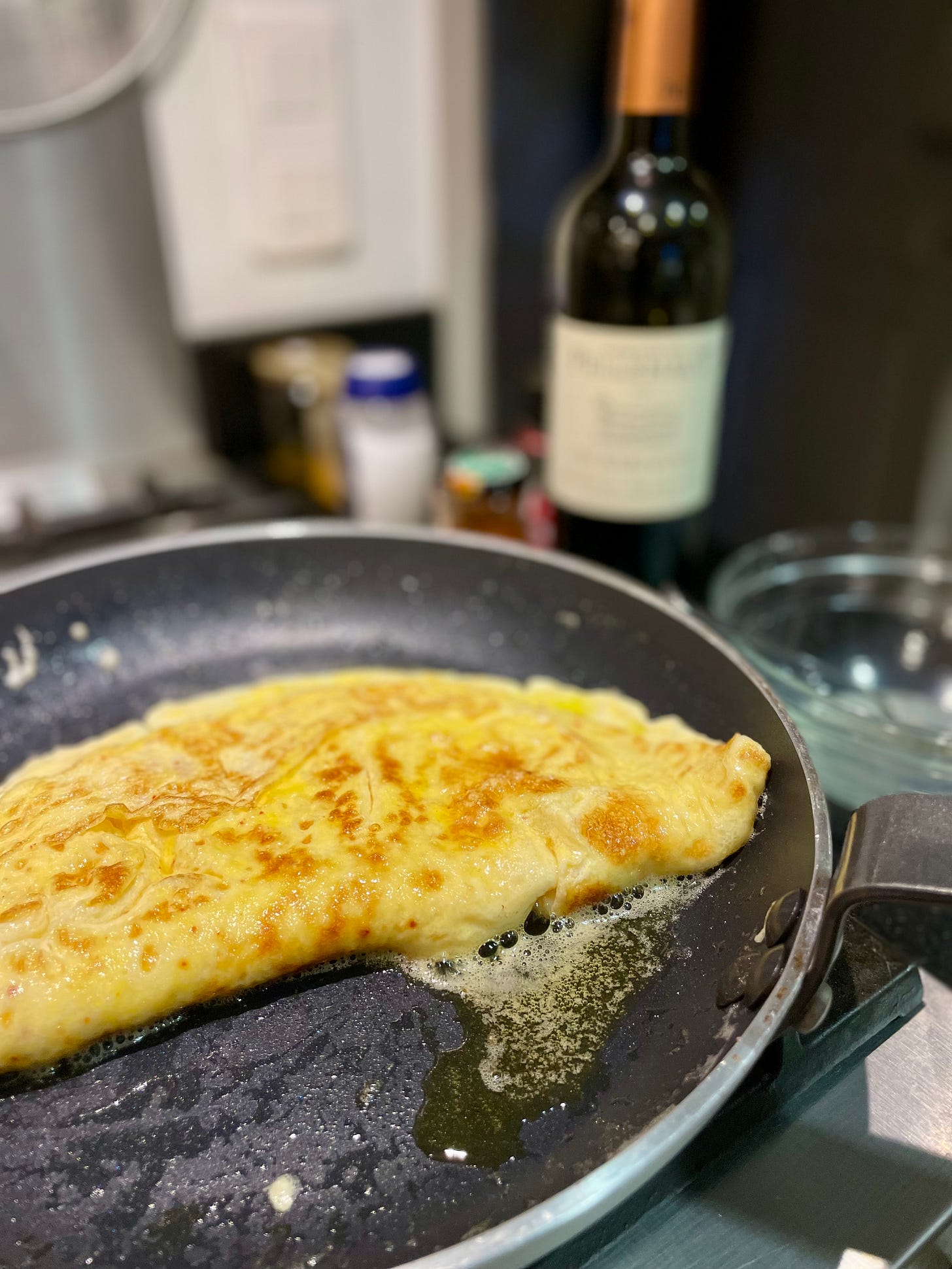There was no explanation, it just happened.
The men were seated around the Château dining table.
In the candlelight, we see them hunched over as they eat little birds in little ramekins, with white linen napkins over their heads and covering their faces.
The birds are called les ortolans and the dish is a delicacy from southwestern France. Diners eat the ortolans with napkins on their heads. Like lobster bibs, but different.
photo © Richard Cottenier/MAXPPP
The scene I just described is from the French film The Taste of Things (La Passion de Dodin Bouffant, in French). The photo above is not from the film.
The polar opposite of high-octane cinema, this movie is perfect for culinarily inclined francophiles. Scenes of cooking and eating are bathed alternately in candlelight and sunlight, to a soundtrack of meat sizzling, utensils scraping on crockery, knives chopping on wooden boards, and quiet background birdsong from the ever-open windows.
It is worth seeing on the big screen, so I will avoid spoilers.
But, we need to talk about the napkins on their heads.
A Potted History of Ortolans
Once upon a time, eating these tiny tiny songbirds was the stuff of banquets and kings, of Napoleon III and Alexandre Dumas, and so revered was the dish that the correct way to eat it was by putting a linen napkin over one’s head. It is said that the napkin allows the diner to fully inhale the aromas, thereby enhancing the taste sensations, but also to shield from Divine Eyes because the way in which these creatures are killed, cooked and consumed is sinful.
Since 1999, it has been illegal to hunt ortolans in France, due to the near extinction of the species. Suffice it to say, this has not fully halted the practice. There is reportedly a black market where the consumption of ortolans is a luxury reserved for the extremely wealthy and those willing to break the law.
How to Cook An Ortolan
Eating animals is nothing new. Eating ortolans is controversial due not only to their near-extinction (contested) but also to the scandal around their preparation.
After capture, the birds are kept in darkness for weeks (some say blinded) and force-fed on millet before meeting their end by drowning in Armagnac. The booze-marinated and seed-fattened tiny birds are then roasted, plucked and brought to the table, still sizzling in their yellow-tinged fat, where they are devoured whole. Bones, innards and all, and generally in one, or at least only a few, mouthfuls.
Those who eat them say the taste is reminiscent of hazelnut.
Those who have never eaten them say, so is gelato. And Nutella.
Remember, this film takes place in the late 1800s so nothing out of the ordinary in eating ortolans, for the epoque. The Taste of Things has been hailed for its culinary realism and authenticity but fear not; in the film, the ortolans were played by small quail, according to the NYT. 1
Who Eats Them?
Maïté is a French cooking show host, from the southwest, with a sturdy demeanour, extensive cuisine skill and a fabulous regional accent. La Cuisine des Mousquetaires was one of her shows, aired on French television between 1983 and 1997, where she cooked along with her co-host Micheline Banzet. You can watch Maïté cooking videos, in French, on YouTube. They are very of their time and place as well as informative and I encourage you to watch a few.
In the clip below, she shows how it is done, the ortolan eating, without the aid of a headpiece. Vegetarians need not watch; it begins about 30 seconds in and if you can stick with it, her ecstasy leads to a brief outburst in southwestern patois:
Not one to miss a polarizing food experience, Anthony Bourdain got in on the tiny bird action too. You can read about the late-night clandestine dinner with New York chefs in his book, Medium Raw, and hear him talk about his ortolan escapades with Stephen Colbert on American television. 2
Fictional Ortolan Eaters
In the American television show, Hannibal, Hannibal and Will partake of an ortolan feast of an evening, in a rare break from their usual protein main dish. Should you wish to watch, the episode is called Kō No Mono.
Fans of the US series Succession may remember the scene where Tom takes Greg to dinner at an exclusive New York pop-up, to welcome him to the 1% Club. During the extensive, multi-course dinner Tom explains to newbie Greg that eating songbird is a privilege and also a little bit illegal. Napkins are involved to heighten the drama, but also because that is how it is done if you are in the know. And Tom wants to be in the know. This takes place in Season 1 and the episode is called Which Side Are You On? Greg’s verdict: "If I eat any more songbirds, I think I'm gonna hurl. "
Damian Lewis had an Ortolan eating scene in the US television show Billions, 3 and the animated series American Dad has an Ortolan episode too.
Meanwhile, Back in France
Former French President François Mitterand, originally from a small town north of Bordeaux, wished his last dinner to be a lavish banquet of oysters and foie gras and capon and multiple fine wines, and ortolans. It was 1996, not yet illegal, and his wish became a reality. He was in the very late stages of terminal cancer and it was genuinely the last meal he ever ate though he did not die until several days after.
The fascinating story of this meal features in Act Two of the 2007 Poultry Slam episode of the stellar podcast This American Life.4 In it, host Ira Glass and his interviewee, the writer Michael Paterniti, who wrote an article for Esquire magazine on Mitterand’s Last Meal, explain that the ortolan symbolizes the French soul; because it was the food of Kings. I am not convinced by this explanation; says who? And how do you know, whether you are eating a soul or just a bird? But Paterniti knows a thing or two about the illicit songbird-eating ritual; he ate an ortolan in France and writes about it, in detail, in the article.5
As recently as 2014, a group of celebrated and Michelin-starred French chefs from the southwest have been trying to put ortolan back on menus. Just one weekend per year is what they want because, it is, after all, a culinary tradition that dates back to Roman times. They are looking at this through the lens of preserving traditions and regional heritage; they have not yet been successful.6
How Much Would You Pay For an Ortolan Dinner?
The story I most enjoyed during my foray into Ortolan lore, is the tale of a meal shared by Craig Clairborne and Pierre Franey back in 1975.
Both gentlemen were prominent American food writers and restaurant critics at that time. The article, which details the why and the how, is in the NYT archive7 and it reads like a menu from the movie. Except this happened IRL and, when it did back in 1975, in Paris, it was costed at about $4,000. A 1918 Château Latour was involved, as were oysters and lobsters, foie gras and partridge and things sauced with truffles, to name but a few. And ortolans, though no mention of napkins. In total, there were 31 dishes.
According to an online inflation calculator, $4,000 in 1975 is worth about $23,000 in 2024. And it wasn’t even their last meal.
A Recipe for February
As the film is now on general release in the English-speaking world, the internet is awash with pot-au-feu recipes inspired by the film. Because pot-au-feu is central to the plot.
But how to choose one recipe, in a film where there are so many: The vol-au-vent with cockscombs and crayfish looked especially nice, I think, and there were also quenelles, a classic, but my favourite has to be the whole turbot, poached in milk and aromatics, all simmering together in a pan the exact shape of the fish. The cooking dish, a diamond-shaped baking pan, was just the best thing. I have never seen one but I trust the crew to have sourced an authentic 19th-century implement. A gap in my cookware batterie has just been identified.
Towards the end, there is an ever-so-gentle yet powerful scene where the two main characters share an omelette. In a film where complex dishes and lavish meals come at you in relentless succession, it is a defining moment.
Just an omelette, and a glass of wine.
They sit together at the table in the kitchen.
Everything slows down as the pair savour the simple food, and each other’s company.
An Omelette
You will need:
A medium size non-stick skillet
A fork
A mixing bowl
1-2 dinner plates
3-4 eggs, farm fresh if you can, free range at a minimum and do not worry about the size, they did not worry about egg size in the 1800s
Unsalted butter
Salt and pepper
Red wine, go Loire Valley/Anjou if you want to be true to the film
A baguette, sliced
No filling, just eggs. And butter.
Crack the eggs into the bowl and whisk vigorously with the fork. Season well with just salt for now.
Heat a very generous knob of butter in the pan over medium heat. If you want to be fancy, use clarified butter because this will help to avoid brown specks which are to be avoided if you want to achieve omelette perfection. For regular people, just butter is fine. Do not skimp.
Heat the butter until melted and just sizzling, then tip in the eggs.
Swirl if needed to even the eggs but don’t lift the pan away from the heat for too long. As soon as it starts to set, use the fork to gently lift the edges to allow some of the uncooked eggs to flow underneath. And just generally use the fork to keep the egg level even. Manage the heat too so the bottom cooks without too much browning.
A “perfect” omelette should still be slightly runny in the middle and never browned on the outside (mine are often golden brown if that makes you feel better; I am impatient). The eggs will keep cooking from residual heat once it is folded over, so stop the cooking while there are still runny bits on top. If you like a well-cooked omelette, ignore me.
When the eggs get to the desired cooked stage, take the pan off the heat and tilt it towards one of the plates. Using the fork, fold it in half and start sliding it towards the plate. I usually stop at this stage because I like the middle to be runny and I’m fine with a half-moon shape, but old-school omelette rules say it should be folded one more time, to form a roll.
Serve immediately, pouring any butter left in the pan on the omelette. You can also have some extra melted butter on hand to brush along the top. Now, use the black pepper mill if you so desire.
Don’t forget beautiful crystal glasses for the wine, which you pour from a decanter, and a wicker basket of thickly sliced baguette. Linen napkins optional.
Take your time.
Bon appétit.
Footnotes & Links for further reading
https://www.nytimes.com/2023/12/11/dining/the-taste-of-things-juliette-binoche.html
https://www.nytimes.com/2014/10/15/dining/the-ortolan-a-tiny-songbird-as-a-french-cause-celebre.html.
Because of different restrictions in different countries, not everyone will be able to see the Stephen Colbert clip, but try a Search and see what you get.
https://www.cnbc.com/2018/05/04/real-story-about-the-illegal-ortolan-delicacy-eaten-on-billions.html
https://www.thisamericanlife.org/343/poultry-slam-2007
https://www.esquire.com/news-politics/a4642/the-last-meal-0598/
Again, this one: https://www.nytimes.com/2014/10/15/dining/the-ortolan-a-tiny-songbird-as-a-french-cause-celebre.html
https://web.archive.org/web/20200602083350/https://www.nytimes.com/1975/11/14/archives/just-a-quiet-dinner-for-two-in-paris-31-dishes-nine-wines-a-4000.html
Enough About Ortolans
I enjoyed this interview, in English, with the Director, because I love a bit of geekery about French food and film and this has it all. Perhaps you will enjoy it too.







Loved the article, Laura, and now I want an omelette and a glass of wine! 🍷 🍳
So fascinating, I knew Ortolan were on Mitterand’s wish list for his last meal, but not the history of them. About twenty five years ago we bought a bottle of wine, and translated the ‘good with’ list: lamb, cheese etc and then were rather shocked by the final suggestion : little thrushes! I simply couldn’t eat a songbird!